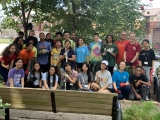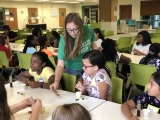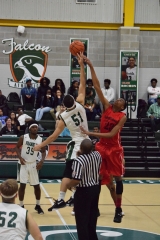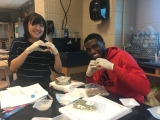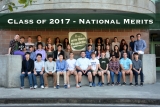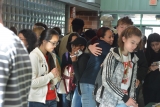-
Category 1
Selected in 2019
-
Grades: 9 - 12
School Setting: urban
Town Population: 393,000
Student Enrollment: 998
Student Demographics:
Black/African American: 30%
Teacher/Student Ratio: 1:23
White/Caucasian: 36%
Hispanic: 7%
Hawaiian/Pacific Islander: 0%
Asian: 19%
Native American: 0%
Other: 8%
% Reduced Lunch: 39%
% ELL Learners: 0%
Founded: 1957 -
PRINCIPAL:
Dr. Patrick Widhalm -
CONTACT:
2001 Leon C Simon
New Orleans, LA 70122
504-286-2600
pwidhalm@bfhsla.org
Benjamin Franklin High School
New Orleans, LA
It is critical to keep the school's mission, vision, and values in mind, and to use them to define initiatives and address challenges.
- Describe specific programs in place to ensure that families are involved in the success of your school and students.
- At this time, there are no formal programs that involve families. During the past several years, participation in Parents' Association meetings has gone to zero. A parents' Facebook page, along with scheduled parent/teacher nights help to provide communication, and parents and teachers can communicate via email and conferences. Parents also have access to PowerSchool and can access each teacher's Google Classroom in order to track assignments and grades.
- Describe the most successful activity your school has initiated to strengthen ties to your community.
-
Benjamin Franklin High School uses the Iowa Test of Basic Skills to determine eligibility for admission, and each year approximately 300 students from every zip code in the city and from 80+ different middle school are offered admission as 9th graders. The admissions director visits schools, talk with parents, and invites groups to visit Franklin. Students who take the admissions test in November or December, and who do not meet the qualifying score are offered the opportunity to re-test. There is no cost to the student/family for testing.
The school also has several outreach programs to middle school students. Student-to-Scientist sends Franklin students into area middle school to conduct after school science labs. A Saturday program in the fall invites middle school students for three hour morning workshops around robotics, coding, and design. Three Saturdays during the school year, the school's Society of Women Engineers counducts a STEM workshop for middle school girls. - Describe your philosophy of school change or improvement.
- It is critical to keep the school's mission, vision, and values in mind, and to use them to define initiatives and address challenges. Change and improvement are the result of teachers working with students, so it is important to have students and teachers as part of the dialogue about change, challenges, and improvements.
- What are your school’s top two goals for the next year?
- An annual goal for Franklin students, faculty, and administration is to maintain the state's top rankings as a by-product of our work. Within the next year, we also have as a goal the start of construction on a campus expansion that will improve facilities and allow for continuing enrollment growth.
- What is the single most important factor in the success of your school that others could replicate?
- In its 63-year history, Franklin has also been built around a strong curriculum. Each year, there are 25 to 30 Advanced Placement courses offered. Additionally, teachers are high qualified to deliver their content area. Finally, because students apply and test to get into Franklin and must maintain a 2.0 GPA, students are purposeful and working toward future goals. Motivated students and qualified faculty engaging with a rich and meaningful curriculum lead to success.
- Describe the program or initiative that has had the greatest positive effect on student achievement, including closing achievement or opportunity gaps, if applicable.
- The implementation of 9th Grade Seminars three years ago has provided an important baseline program to help all students acclimate to the expectations, academic and social, of Franklin. As the school has admitted students from more and more of the middle schools in New Orleans, including schools rated as "failing," the seminars have been effective in giving all students strategies for success and self management, as well as a teacher who becomes a "coach" for about 25 students. As mentioned in the response above, the seminars can also be used to group students who the data show might have more difficulties in math or English.
- Explain how ESEA federal funds are used to support your improvement efforts.
- ESEA funds are used to provide appropriate professional development for faculty and staff working with qualifying students and programs. They are also used to bring in consultants to work with school wide initiatives, such as creating a culture of diversity, equity, and inclusion.
- Identify the critical professional development activities you use to improve teaching and student learning.
- Professional development that is delivered by Franklin teachers to Franklin teachers always receives the highest marks. This year, there has been more time set aside for teacher collaboration, both at grade level and within disciplines.
- Describe how data is used to improve student achievement and inform decision making.
-
The school uses data from the admissions test (Iowa Test of Basic Skills) to create seminar groups of 9th grade students who might have gaps in their math or English skills. This has had a very positive impact on retention at the end of the 9th grade. (In order to remain at Franklin, a student must maintain a 2.0 GPA at the end of each year.) The retention rate has improved from 89% to 95%.
There is a goal this year to incorporate data into teacher collaboration. This can be data from standardized tests or from internal tracking.
- Describe your school culture and explain changes you’ve taken to improve it.
- Benjamin Franklin High School is privileged to work with the most diverse student body in the city. There is no ethnic majority, and students are from all socioeconomic backgrounds, with approximately 35% qualifying for free and reduced lunch, along with a number of Special Education students, including gifted and talented. Properly meeting the needs of all students and engaging them in learning has led to professional development foci in the past three years that have included understanding racism; assessing bias; building a community that values diversity, equity, and inclusion; and teaching students who are from poverty. There has also been a growing response from alumni and donors to create a "student enrichment fund" that is used to provide opportunities for students whose families have very limited financial resources. This can range from a ticket to Prom, to airfare for a student to receive an earned award, to paying for Advanced Placement exam.
Stats
-
Category 1
Selected in 2019
-
Grades: 9 - 12
School Setting: urban
Town Population: 393,000
Student Enrollment: 998
Student Demographics:
Black/African American: 30%
Teacher/Student Ratio: 1:23
White/Caucasian: 36%
Hispanic: 7%
Hawaiian/Pacific Islander: 0%
Asian: 19%
Native American: 0%
Other: 8%
% Reduced Lunch: 39%
% ELL Learners: 0%
Founded: 1957 -
PRINCIPAL:
Dr. Patrick Widhalm -
CONTACT:
2001 Leon C Simon
New Orleans, LA 70122
504-286-2600
pwidhalm@bfhsla.org


